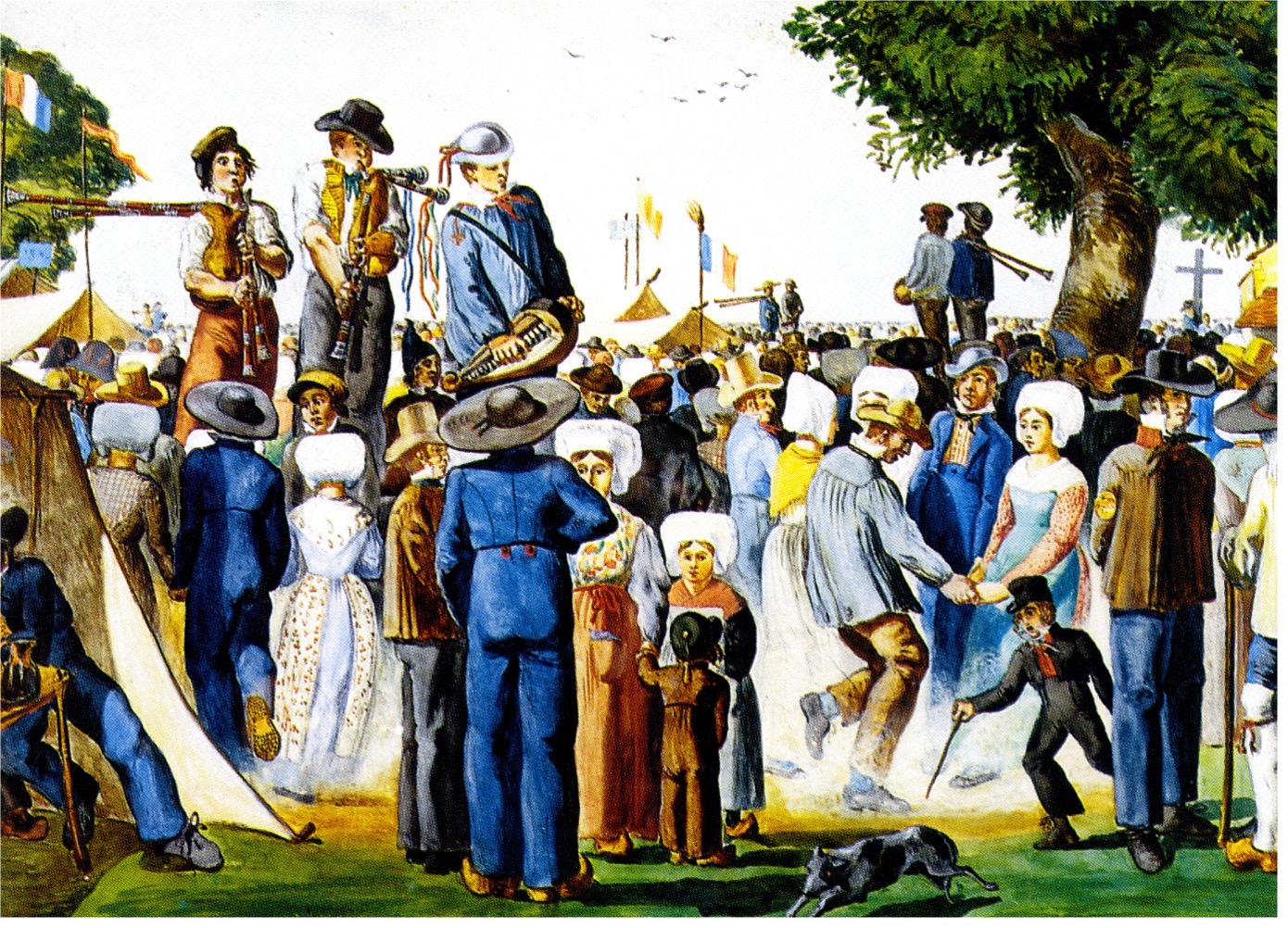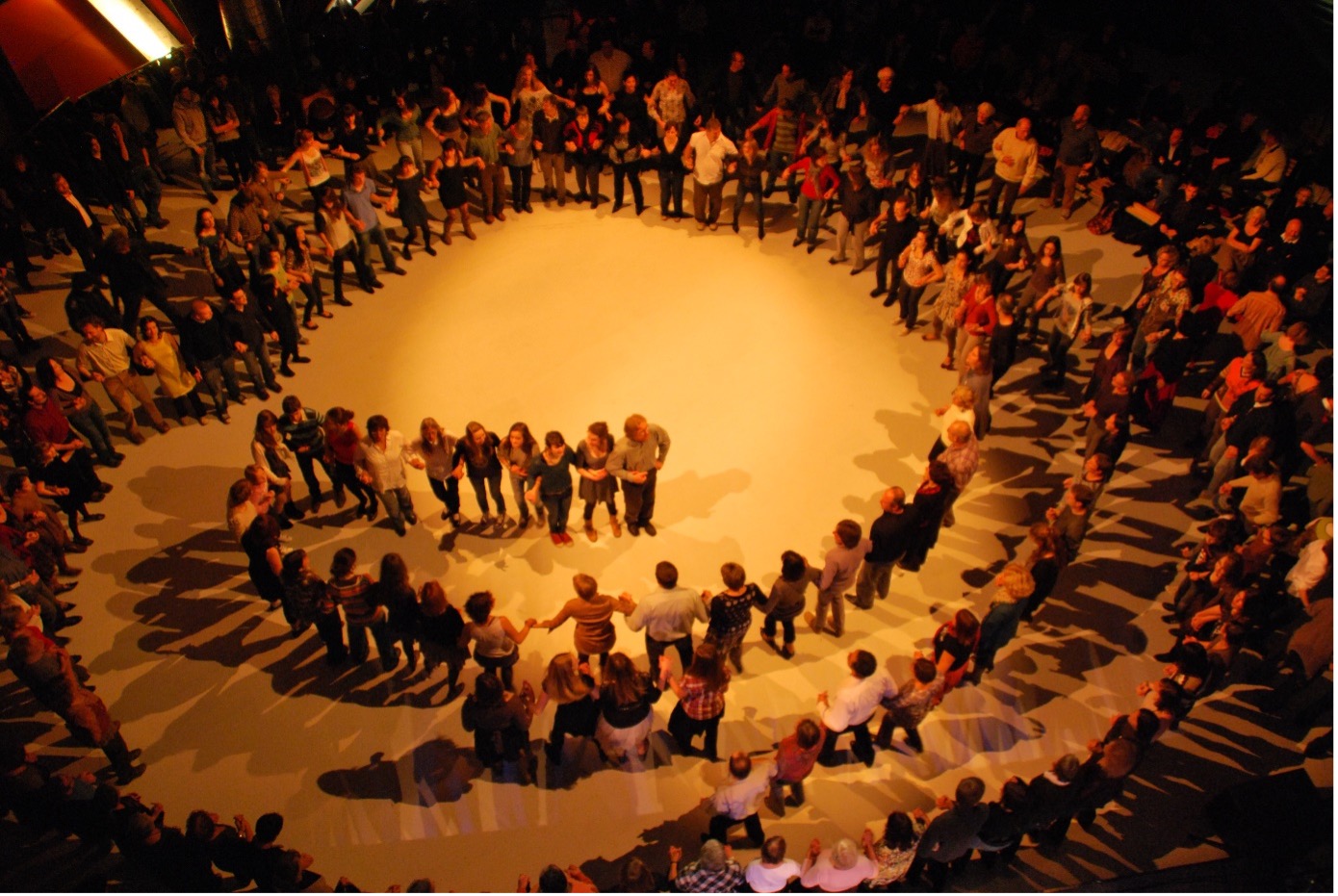French traditional music

Several cultural areas are represented within French traditional music and dance, this page is about metropolitan France ; cultural areas will be presented soon.
Historical background
19th century
French literati began to take an interest in the “sung poems of the little people from the countryside”, as some called them, towards the middle of the 19th century during the Romantic movement. The word ‘folklore’ was adopted by all collectors to designate the habits and customs of the peasants. It was at this time that George Sand, a writer famous for her peasant novels, took composer Frédéric Chopin to listen to the bourrées, traditional dances of Berry played on the bagpipes and hurdy-gurdy.
Folklorists criss-crossed the regions of France and produced numerous publications, mainly based on song collections. The state commissioned a survey (1852-1876) under the impetus of Hippolyte Fortoul, Minister of Public Education and Worship.
Regionalism and nationalism joined this movement towards the end of the 19th century. The first folklore groups were born with the aim of reviving traditions that were already considered to be in decline at that time.

20th and 21st centuries
Ethnography and ethnology developed in the 20th century. Researchers focused more scientifically on songs, then, later on instrumental practices and finally, only towards the middle of the 20th century, on dances.
For many decades, popular education movements have been developing an interest in folklore and collecting. Courses were set up and workshops formed. Songs and dances were practiced, languages were learned, and knowledge was acquired about Popular Arts and Traditions, a term that encompassed the practices of the collected societies.
The collections multiplied in the 1970s during the revivalist movement, which continued to inspire research, creation, and dissemination. This research brought to light forgotten traditions and instruments such as the Vosges spruce or the Limousin chabrette.
This movement popularized the practice of folk dances or trad dances which constitute an important part of the traditional music and dance movement today.

Organology
The instrumentarium of the French domain is very diverse, with each family having more or less important variations. Musicians often made their own instruments. Manufactured instruments gradually appeared in the second half of the 19th century, the violin and the accordion being the most widespread.
Wind instruments
Bagpipes, oboes, flutes, clarinets, accordions, fifes, alphorns
String instruments
Hurdy-gurdies, violins, epinets
Percussions
Tambour, tambourine, rattles, bells and various sound objects
Genres
Traditional music and dance in the French domain are culturally, linguistically and geographically diverse. From metropolitan France to the overseas territories, the traditions present a variety of practices in :
– Songs that cross the space of the village, the neighborhood, the workplace, festivals and rituals;
– The dances which mix sung rounds, contradances, dances by couples and dances dedicated to a sacred or profane commemoration;
– Organology, which presents widely used instruments such as the violin or the diatonic accordion. And others whose variations are more local: bagpipes, hurdy-gurdies, oboes, zithers, drums, flutes…
The multiplicity of linguistic, economic and cultural areas makes it difficult, if not impossible, to identify a single genre. Nevertheless, for metropolitan France, we note the predominance of enumerative songs, a constantly recurring formula with the addition of an element to each new verse (Derrière chez nous Ah devinez ce qu’il y a) or songs of ten (Mon père est marchand de noix, 10 sous la douzaine). The latter form is often linked to sung rounds, which are also very common.
Cultural areas
Find below ressources for each region of metropolitan France ; other cultural areas will be added in the future
- Breton music
- Occitan music
- Introduction to music from Poitou
- French Flander
- Spring living tradition “Les Réveillez”
Reference works
Metropolitan France (by year of publication)
- Chansons françaises de tradition orale 1 900 textes et mélodies collectés par Patrice Coirault / revised and completed by Marlène Belly and Georges Delarue : éditions de la Bibliothèque nationale de France, 2013
- Langue, musique, identité Actes du colloque de Poitiers / Editions Publibook, 2011
- Des racines au rhizome Actes des Assises nationales des musiques et danses traditionnelles / FAMDT Modal 2009
- Danse traditionnelle et anciens milieux ruraux français / Jean-Michel Guilcher Paris : Editions l’Harmattan 2009
- La danse traditionnelle en France / Yves Guilcher Parthenay : ADP-FAMDT, 2e éd., 2001
- L’air du temps, du romantisme à la world music / Collectif Editions Modal (soon available on Modal Média), FAMDT 1993
- Collecter la mémoire de l’autre / Collectif Editions Modal (soon available on Modal Média), UPCP 1991
- Formation de nos chansons folkloriques / Patrice Coirault Paris : Editions du Scarabée, 1953-1959. 4 vol.
Other resources
- Modal, the resource media for traditional music and dance : news, resources and archives on oral cultures
- Inter-regional oral heritage database
- Federation of actors of traditional music and dance
- Portal of oral heritage : collective catalogue of sound and audiovisual archives on oral traditions
- UPCP-METIVE Union pour la Culture Populaire en Poitou-Charentes et Vendée : create, disseminate, transmit, resources…
- Discover the oral heritage archives of Brittany
- Les Réveillées: musical ethnographies of French and Francophone territories (1939-1984)
- Popular violins in New Aquitaine
- Recordings of the Archives de la Parole, made from 1911 onwards by Ferdinand Brunot, linguist and professor of the history of the French language at the Faculté des lettres de Paris
- Network of oral archives and documentation: ethnographic archive base